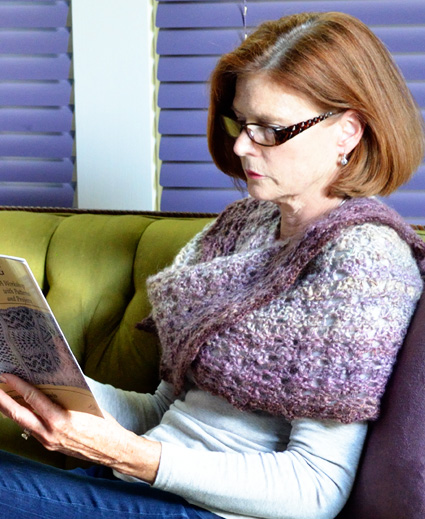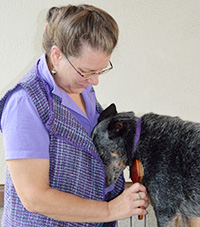NAME, a free knitting pattern from Knitty.com. Free knitting pattern for a DETAILS HERE.
INTRODUCTION
Threefer

![]()
I’m moving from a larger house in the country to a smaller, downtown home built in 1907. Among many other things, this means packing my stash. Boy howdy! The best news is discovering forgotten treasures, such as the dyed Cotswold locks bought from Sue Smith at the Middle Tennessee Fiber Festival several years ago. These dyed locks from her flock are perfect to hand pick and spin long-draw. Which is good, since the picker and drum carder can only be seen over stacks of packing boxes, and I am in real need of a spinning fix.
There are two coordinating colorways in the locks, perfect for a gradient yarn. By dividing the locks evenly by weight but unevenly by color, the final 2-ply yarn softly blends from color to color.
The shawl is a crescent worked from center back down, using any weight yarn to desired wingspan. My design goals sent me exploring Orenburg and Shetland lace stitches. I wanted a reversible design that was easy to remember and work, while not looking so easy. The garter based pattern makes a textured fabric with yarn overs to lighten things up and form a lovely mesh.
It has lots of threes, including the cast on, k3tog decrease, neckline edge, row repeat, and center shaping. The stitch pattern is 2 threes: k3 and (YO, k3tog, YO). And finally, each 3-row repeat adds three stitches at the edges, automatically stepping the stitch pattern.
 model: Deborah Kitchen
model: Deborah Kitchen
 photos: Jennifer Adair
photos: Jennifer Adair
SIZE
One
FINISHED MEASUREMENTS
Handspun and commercial yarn versions, after blocking:
Width: 68 inches
Height: 22 inches
MATERIALS
Fiber:
![]() Hand dyed multi-color Cotswold locks from Sue Smith (blackberryhillfarm.net); 9 oz, unnamed color. Hand picked with some hand carding. Yarn: 325yd/296m in 8 oz with 1 oz of waste.
Hand dyed multi-color Cotswold locks from Sue Smith (blackberryhillfarm.net); 9 oz, unnamed color. Hand picked with some hand carding. Yarn: 325yd/296m in 8 oz with 1 oz of waste.
Finished Yarn:
![]() Wraps
per inch: 8
Wraps
per inch: 8
![]() Ply:
2
Ply:
2
![]() Yardage
used: all
Yardage
used: all
![]() Drafting method: modified long draw
Drafting method: modified long draw
Commercial yarn alternative (not shown - will replicate handspun look):
![]() Twisted Fiber Art Evolution Gradient yarn base Kabam [60% Superwash Merino/30% Bamboo/10% Nylon; 400yd/364m per 100g “Medium” ball]; color: Purple Rain; 1 ball (note put-up size)
Twisted Fiber Art Evolution Gradient yarn base Kabam [60% Superwash Merino/30% Bamboo/10% Nylon; 400yd/364m per 100g “Medium” ball]; color: Purple Rain; 1 ball (note put-up size)
Commercial yarn version:
![]() Louet Euroflax [100% wet spun linen; 270yd/246m per 100g ball]; color: Lake Placid; 2 balls, 330yd/300m used
Louet Euroflax [100% wet spun linen; 270yd/246m per 100g ball]; color: Lake Placid; 2 balls, 330yd/300m used
Recommended needle size
[always use a needle size that
gives you the gauge listed below --
every knitter's gauge is unique]
![]() Handspun version: 40-inch US #9/5.5mm circular needle
Handspun version: 40-inch US #9/5.5mm circular needle
![]() Commercial yarn version: 40-inch US #5/3.75mm circular needle
Commercial yarn version: 40-inch US #5/3.75mm circular needle
Tools
![]() yarn
needle
yarn
needle
![]() stitch markers
stitch markers
Gearbox
![]() spinning tool: Windwheel
spinning tool: Windwheel
![]() lazy kate: Majacraft
lazy kate: Majacraft
![]() plying tool: Hansen
plying tool: Hansen
GAUGE
12 sts/15 rows = 4 inches/10cm in stockinette stitch in handspun, after blocking
11 sts/11 rows = 4 inches/10cm in pattern stitch in handspun, after blocking
12 sts/15 rows = 4 inches/10cm in stockinette stitch in linen, after blocking
11 sts/11 rows = 4 inches/10cm in pattern stitch in linen, after blocking
Gauge is not very important in this pattern. Choose a needle size that gives a fabric you like. It is easier to work the k3tog decrease with loose tension and pointier needle tips.
PATTERN NOTES
[Knitty's list of standard abbreviations and techniques can be found here.]
SPINNING NOTES
To make a gradient yarn, sort and group the fiber before spinning. Weigh the total fiber available, then sort all of it by color into 2 to 4 groups. For hand dyed roving, pull apart color sections as necessary. Weigh each color group. To make a 2-ply yarn, divide the colors unevenly by weight while keeping the fiber for each single equal to half the total.
For example, 9 oz total with 3 oz each of colors A, B, and C:
Single 1 could be 1 oz A, 1.5 oz B, 2 oz C, total 4.5 oz
Single 2 could be 2 oz A, 1.5 oz B, 1 oz C, total 4.5 oz
Instead of doing the math, just divide the colors equally, giving half of each to Single 1 and half to Single 2. Take 1 oz or so of the first Single 1 color and put it with the Single 2 stash. Take the same amount of the last Single 2 color and put it with the Single 1 stash.
Spin each single in the same order (A, B, C in first example) and ply starting with both Cs (or As) held together.
PATTERN NOTES
K&R: Knit 1, return new stitch to left needle. Does not change stitch count. This step loosens up the edge stitch on the upper edge of the piece, allowing it to stretch to match the fabric.
Ch: Chain stitch using a crochet hook if desired. Yarn over, pull loop through all loops on hook.
BO2: K1, ch2.
BO3: K1, ch3.
To next YO: Used in bind off only, refers to the next YO in the last lace pattern row worked before the bind off. If your last row was a plain knit row, work to the stitch that sits above the yo – the ‘daughter’ or ‘granddaughter’, as appropriate.
Since the pattern is a 9-row repeat, right and wrong sides reverse every third row.
The first row of each 3-row repeat is a pattern row. The next two rows are plain garter with an increase on each end. Each k3 of the pattern stitch is worked over the (YO, k3tog, YO) that was worked 3 rows below, making it easy to keep track of the pattern.
Reserve four to five times as much yarn for the bind off as needed for a plain knit row (2, 3, 5, 6, 8 or 9) (the YOs on the lace pattern rows take less yarn) near the bottom edge of the shawl. Before working a row, measure the yarn by stretching a section from your extended right hand to left shoulder, about a yard. At 5 yards, fold the yarn over and tie an easily removed slip knot to mark the spot. While knitting the row, add additional yards or measure what is left over to determine your yards per row.
DIRECTIONS
Setup
CO 3 sts
Row 1: K&R, kfb twice, k1. 5 sts.
Row 2: K&R, kfb, (k1, YO) twice, kfb, k1. 9 sts.
Row 3: K&R, (k1, YO) twice, k5, (YO, k1) twice. 13 sts.
Row 4: K&R, (k3, YO) twice, k1, (YO, k3) twice. 17 sts.
Row 5: K&R, k3, YO, k to last 3 sts, YO, k3. 19 sts.
Row 6: K&R, k3, YO, k6, YO, k1, YO, k6, YO, k3. 23 sts.
Row 7: K&R, k3, YO, k to last 3 sts, YO, k3. 25 sts.
Row 8: Repeat row 7. 27 sts.
Mark the center stitch, either by placing stitch markers either side of it, or a removable stitch marker in the fabric, around the base of the stitch. If you use a removeable marker, move it up as you work.
Body
Row 1: K&R, k3, yo, [k3, yo, k3tog, yo] to 4 sts before center stitch, k4, yo, k1, yo, k4, (YO, k3tog, YO, k3) to last 3 sts, YO, k3. 4 sts increased.
Row 2-3: K&R, k3, YO, k to last 3 sts, YO, k3. 2 sts increased.
Row 4: K&R, k3, yo, [k3, yo, k3tog, yo] to 2 sts before center stitch, k2, yo, k1, yo, k2, (YO, k3tog, YO, k3) to last 3 sts, YO, k3. 4 sts increased.
Rows 5-6: K&R, k3, YO, k to last 3 sts, YO, k3. 2 sts increased.
Row 7: K&R, k3, yo, [k3, yo, k3tog, yo] to 6 sts before center stitch, k6, yo, k1, yo, k6, (YO, k3tog, YO, k3) to last 3 sts, YO, k3. 4 sts increased.
Rows 8-9: K&R, k3, YO, k to last 3 sts, YO, k3. 2 sts increased.
Repeat Row 1-9 until piece is desired length, or you’re almost out of yarn. Reserve 4-5 times the row’s width in yarn for the BO. It doesn’t matter which row you end with.
Bind off very loosely as follows:
With side facing ready to bind off, place m on needle 2 sts before center stitch. Using a crochet hook in place of right needle, slip 1, BO2 twice, BO3, BO2 to next YO, (BO3 twice, BO2 to next YO) to m (ending with a BO2), BO3 four times, BO2 to next YO, (BO3 twice, BO2 to next YO) to last 4 sts, BO3 once, BO2 to last st, slip 1, ch1, and secure.
FINISHING
Wet block as desired. Weave in ends.
The handspun version is a very woolen yarn and received a fulling finish before knitting. The shawl was hand washed, spun out in a front load washer with wet laundry, and stretched on a blocking mat. (Skip the spin out for a worsted spun yarn.) Points were generated by pinning through the center stitch of every other rib (between YOs), beginning at center back.
The commercial yarn version in linen was washed with a load of laundry, stretched by hand, hung from a line by a clip at each wingtip, and air dried.
ABOUT THE DESIGNER
 After spending years in the construction industry, Jennifer Adair ran off to join the circus and make her living as a craft artist working in glass and fiber. She has accumulated over a pound of Blue Heeler undercoat from Zeke, whose favorite words are “Ready to get carded?”
After spending years in the construction industry, Jennifer Adair ran off to join the circus and make her living as a craft artist working in glass and fiber. She has accumulated over a pound of Blue Heeler undercoat from Zeke, whose favorite words are “Ready to get carded?”
You can find out more on her website. You can also find her on Ravelry as IndigoKiwi.
Pattern & images © 2016 Jennifer Adair. Contact Jennifer